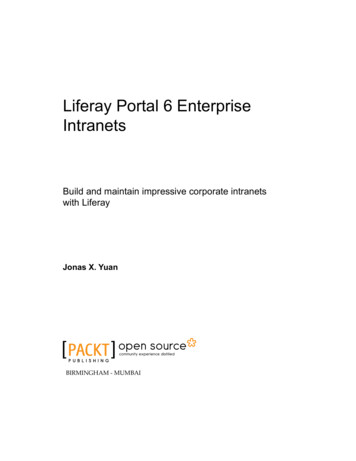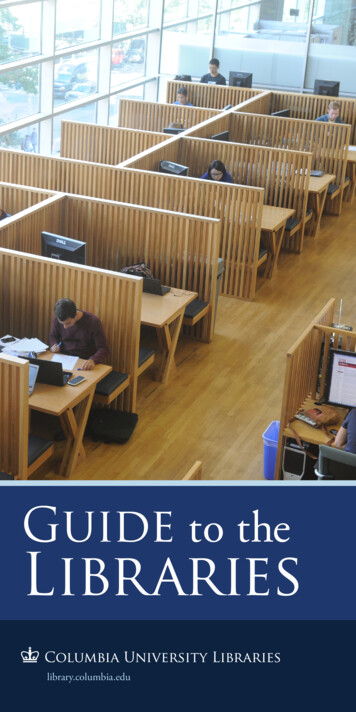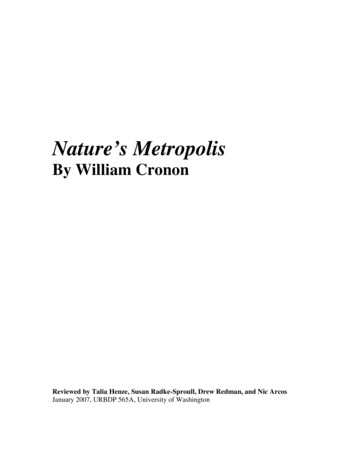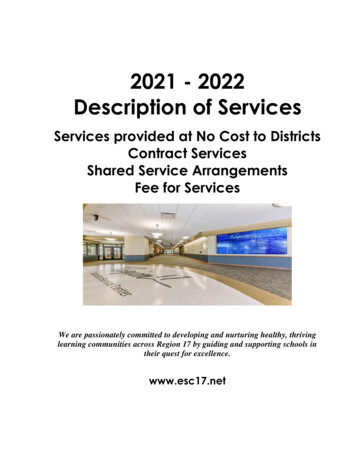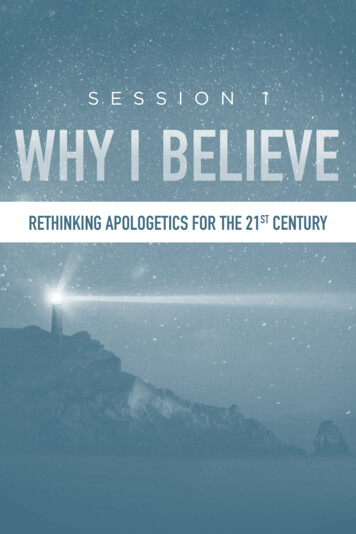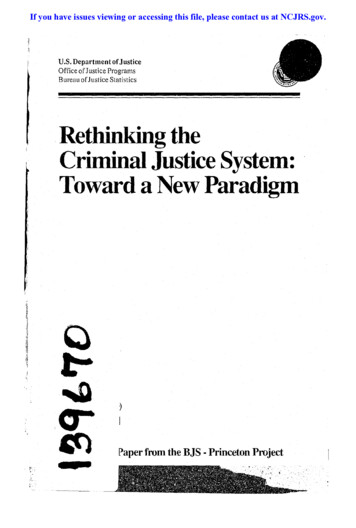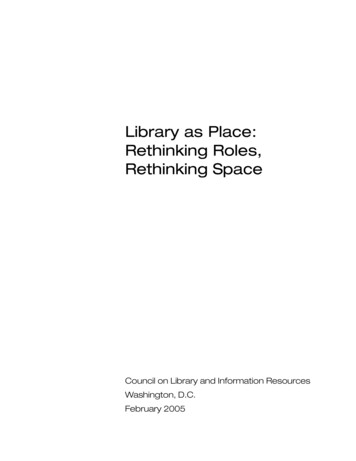
Transcription
Library as Place:Rethinking Roles,Rethinking SpaceCouncil on Library and Information ResourcesWashington, D.C.February 2005
iiISBN 1-932326-13-8ISBN 978-1-932326-13-0CLIR Publication No. 129Published by:Council on Library and Information Resources1755 Massachusetts Avenue, NW, Suite 500Washington, DC 20036Web site at http://www.clir.orgCopyright 2005 in compilation by the Council on Library and Information ResourcesAdditional copies are available for 20 per copy. Orders must be placed through CLIR’s Web site.This publication is also available online at no charge at 8The paper in this publication meets the minimum requirements of the American National Standardfor Information Sciences—Permanence of Paper for Printed Library Materials ANSI Z39.48-1984.
iiiContentsAbout the Authors .vPreface . viiThe Library as Place: Changes in Learning Patterns, Collections,Technology, and Useby Geoffrey T. Freeman .1Righting the Balanceby Scott Bennett . 10From the Ashes of Alexandria: What’s Happening in theCollege Library?by Sam Demas . 25The Ultimate Internet Café: Reflections of a Practicing Digital Humanistabout Designing a Future for the Research Library in the Digital Ageby Bernard Frischer . 41Space Designed for Lifelong Learning: The Dr. Martin Luther King Jr.Joint-Use Libraryby Christina A. Peterson . 56The Johns Hopkins Welch Medical Library as Base:Information Professionals Working in Library User Environmentsby Kathleen Burr Oliver . 66Afterword .76For Further Reading . 77
iv
vAbout the AuthorsScott Bennett is Yale University librarian emeritus. He has had extensive experience with library planning, construction, renovation, and restoration atYale and in his service as the Sheridan Director of the Milton S. EisenhowerLibrary at Johns Hopkins University and as assistant university librarian forcollection management at Northwestern University. As one of the founders ofProject Muse, he fostered changes in information use that drive innovationsin the use of library spaces. Bennett has served on both the library and theEnglish department faculties of the University of Illinois at Urbana-Champaign. He is the author of the recent CLIR publication Libraries Designed forLearning. He is senior adviser for the Library Project of the Council of Independent Colleges.Sam Demas is college librarian and senior lecturer at Carleton College. Heand his staff are experimenting with the development of the liberal arts college library as both a virtual space and a vibrant place of student research,community building, and cultural events. He and his colleagues are workingto define the role of the library in a residential learning community. Beforecoming to Carleton in 1998, Demas worked at Cornell University for 20 yearsin a variety of positions and libraries, including head of collection development and preservation at the A. R. Mann Library and associate director ofMann Library. His research interests at Cornell were selection for preservation, national preservation planning, and adapting the principles and practices of collection development to the electronic library.Geoffrey T. Freeman, AIA, is a principal of Shepley Bulfinch Richardson andAbbott, a Boston-based design firm. A nationally recognized authority onlibrary planning and design, Freeman has designed more than 80 libraries.His chief interest is in contributing to the advancement of education, to understanding how people learn, and to heightened appreciation of how architecture affects the teaching and learning processes. Freeman has taught at thesecondary school level and was an instructor in the Department of Visual andEnvironmental Studies at Harvard College while earning his master of architecture and master in landscape architecture degrees from the Harvard University Graduate School of Design. His clients include Colby College, BrownUniversity, Bucknell University, Emory University, the University of Southern California, Princeton University, Illinois Wesleyan University, ColumbiaUniversity, Dartmouth College, Lake Forest College, Harvard University,Yale University, Rice University, and Duke University. He frequently lecturesabout the design of libraries for research universities and liberal arts colleges.
viBernard Frischer is director of the Institute for Advanced Technology in the Humanities, University of Virginia. From 1976 to 2004he was professor of classics at the University of California, Los Angeles (UCLA), where he founded and directed the Cultural VirtualReality Laboratory, chaired his department, and was director of theUCLA office of the Education Abroad Program of the Universityof California. In addition to his work in digital archaeology, he hasbeen involved in fieldwork and excavation, serving as director of theHorace’s Villa Project of the American Academy in Rome (1996 to2003) and of the Frontale di Borgorose Project (2004 to the present).Frischer earned his BA in classics from Wesleyan University and hisPhD in classical philology from the University of Heidelberg. Hehas won many fellowships and awards, including a Michigan JuniorFellowship, the Rome Prize Fellowship in Classics from the American Academy in Rome, two Senior Fellowships from the AmericanCouncil of Learned Societies, and a Senior Fellowship at the Centerfor Advanced Studies in the Visual Arts at the National Gallery inWashington, D.C. He is the author of four books and many articles.Kathleen Burr Oliver, MSLS, MPH, is associate director of theWelch Library and responsible for the library’s communication andliaison programs. She also serves as a faculty member in the JohnsHopkins Division of Health Sciences Informatics. Before coming toHopkins in 1998, Oliver managed a number of small scientific andmedical libraries, including those of National Institute of Allergyand Infectious Diseases’ Rocky Mountain Laboratory, the AmericanCollege of Cardiology, and American Medical Association’s Washington, D.C., office. She was a reference librarian and search analystat the National Institutes of Health library, the library of the Pharmaceutical Manufacturers’ Association, and UCLA’s BiomedicalLibrary. She was project director for a literature review on the costof illness that was conducted by Georgetown University’s PublicServices Laboratory, and, with funding from the National ScienceFoundation, developed Web resources on science topics for the public radio documentary group Soundprint. Her public health trainingfocused on maternal and child health policy, planning, and evaluation. She holds an undergraduate degree in biology and chemistry.Christina A. Peterson is a librarian in the Academic Services Department of the Dr. Martin Luther King Jr. Library in San José, California. Her responsibilities include coordinating distance-library services, serving as a liaison to departments in the health professionsand social sciences, and delivering library outreach to faculty. During the planning process for the King Library, she co-led the UserServices Team which developed all public services including reference, circulation, and the new library’s Web site. She received herBS in Natural Resources from Humboldt State University in California and her MSLIS from the Catholic University in Washington D.C.
viiPrefaceWe are still far from the day when students, researchers, and teachers canaccess entire research collections from their desktops. Nonetheless, a wealthof high-quality material is now accessible electronically. What does this revolutionary change mean for the creation and design of library space? What isthe role of a library when it no longer needs to be a warehouse of books andwhen users can obtain information without setting foot in its doors? Few libraries have failed to consider these questions—whether they serve their collections electronically or physically, whether they serve the general public ormore specialized academic users.In developing this publication, CLIR sought to explore these questionsfrom a variety of perspectives. Authors of these essays include librarians, anarchitect, and a professor of art history and classics. The focus is primarily onresearch and academic libraries, although one essay, in describing a uniquemerger, challenges the boundaries that have long divided academic and public libraries. Each author brings a distinctive perspective to thinking aboutthe use and services, and the roles and future, of the library; at the same time,each underscores the central, growing importance of the library as place—orbase—for teaching, learning, and research in the digital age.The publication is intended to stimulate thinking about the role of thelibrary in the digital age, about the potential—and the imperative—for libraries to meet new needs, and about how these needs will influence the designof physical space. It is written for librarians and others involved in libraryplanning as well as for those who invest in libraries, such as provosts, presidents, and business officers. Its goal is not to catalog all the innovation occurring in libraries nationwide but rather to expose an array of perspectives onthe future of the library and to describe how these visions are being manifestin spatial design. We hope that the essays will be useful as a foundation fordiscussion, questions, and new thinking.Kathlin SmithDirector of Communications
1The Library as Place:Changes in Learning Patterns, Collections, Technology, and UseGeoffrey T. Freeman, AIASince the rise of universities across Europe during the Age ofEnlightenment, the academic library has always held a centralposition as the heart of an institution—both symbolically andin terms of its physical placement. Preeminently sited and often heroic in scale and character, the library has served as a visual anchorfor the surrounding buildings on campus. These early academic libraries were very different from those of the monastic tradition fromwhich they emerged. Unlike the medieval cloistered buildings thatwere frequented only by monks, libraries at such venerable institutions as Cambridge University and Trinity College at the Universityof Dublin were both centers of learning and important gatheringplaces for scholars throughout the Western world. Richly embellished with stained glass windows, paneled with ornately carvedoak, and appointed with marble statuary commemorating Greekand Roman philosophers, these libraries exuded an almost palpablesense of spiritual and intellectual contemplation. As a “temple ofscholarship,” the library as place assumed an almost sanctified role,reflected both in its architecture and in its siting.As developed for more than 200 years, academic libraries in theUnited States and abroad have generally been designed first andforemost as places to collect, access, and preserve print collections.To enter and use them was considered a privilege. Despite theirhandsome exteriors, the interior spaces were often dim and confining, the buildings were difficult to navigate, and specialized servicesand collections were inaccessible to all but the serious scholar. Libraries were revered but, with the exception of providing expanding collections, were comparatively static buildings. Planning anddesign of these facilities were primarily devoted to the preservationand security of materials and to the efficiency of the library collectionservices. Prime space was routinely reserved for processing materials.
2Library as Place: Rethinking Roles, Rethinking SpaceGiven this longstanding practice, it is no surprise that the traditional library we inherit today is not the library of the future. To meettoday’s academic needs as well as those in the future, the librarymust reflect the values, mission, and goals of the institution of whichit is a part, while also accommodating myriad new information andlearning technologies and the ways we access and use them. As anextension of the classroom, library space needs to embody new pedagogies, including collaborative and interactive learning modalities.Significantly, the library must serve as the principal building on campus where one can truly experience and benefit from the centrality ofan institution’s intellectual community.Reinventing the Library—Technology as CatalystWith the emergence and integration of information technology, manypredicted that the library would become obsolete. Once studentshad the option of using their computers anywhere on campus—intheir residence halls, at the local cyber café, or under a shady tree inthe quad—why would they need to go to the library? Those chargedwith guiding the future of a college or university demanded that thisquestion be answered before they committed any additional funding to perpetuate the “library”—a facility that many decision makersoften considered little more than a warehouse for an outmoded medium for communication or scholarship. Many asserted that the virtual library would replace the physical library. The library as a placewould no longer be a critical component of an academic institution.While information technology has not replaced print media, andis not expected to do so in the foreseeable future, it has nonethelesshad an astonishing and quite unanticipated impact on the role of thelibrary. Contrary to the predictions of diminishing use and eventualobsolescence of libraries, usage has expanded dramatically—sometimes doubling or even tripling. These increases are particularlycommon at libraries and institutions that have worked with theirarchitects and planners to anticipate the full impact of the integration of new information technologies throughout their facilities. Atinstitutions where such collaborative planning has occurred—forour firm, at the University of Southern California, Emory University,and Dartmouth College, and more recently, at Fordham University,Illinois Wesleyan University, and Lake Forest College—new libraryusage speaks for itself: The demand for services and technologicalaccess to information, regardless of format, is beyond expectations.The library, which is still a combination of the past (print collections) and the present (new information technologies), must beviewed with a new perspective and understanding if it is to fulfillits potential in adding value to the advancement of the institution’sacademic mission and in moving with that institution into the future. Rather than threatening the traditional concept of the library,the integration of new information technology has actually becomethe catalyst that transforms the library into a more vital and criticalintellectual center of life at colleges and universities today.
The Library as PlaceThe library is the onlycentralized location where newand emerging informationtechnologies can be combinedwith traditional knowledgeresources in a user-focused,service-rich environmentthat supports today’s socialand educational patternsof learning, teaching, andresearch.When beginning to conceptualize and plan a library for the future, we must first ask an obvious question: If faculty, scholars, andstudents can now obtain information in any format and access itanywhere on campus, then why does the library, as a physical place,play such an important role in the renewal and advancement of aninstitution’s intellectual life? The answer is straightforward: Thelibrary is the only centralized location where new and emerging information technologies can be combined with traditional knowledgeresources in a user-focused, service-rich environment that supportstoday’s social and educational patterns of learning, teaching, and research. Whereas the Internet has tended to isolate people, the library,as a physical place, has done just the opposite. Within the institution,as a reinvigorated, dynamic learning resource, the library can onceagain become the centerpiece for establishing the intellectual community and scholarly enterprise.When Shepley Bulfinch Richardson and Abbott prepared theprogrammatic concept for the renovation and expansion of the Perkins Library at Duke University, we asked a student why he usedthe library. He replied that when he “got serious,” that was the onlyplace he wanted to be. This attitude is surprisingly consistent wherever we have recently renovated or added to library facilities. Students at all levels of academic proficiency need and want to go to thelibrary now more than ever before. Going to the library adds value totheir lives and offers many of the tools and experiences that will givethem the competitive edge they will need to succeed after their formal education is completed. There is an expectation that the libraryis the place to be; it is where the action is.People often ask, “What recently completed library can I visitthat exemplifies the perfect library design?” Consistently, and regretfully, we reply that no single, ideal example exists. When undertaking a new project, it is important to analyze a wide variety ofsuccessful planning and design elements from as many projects aspossible. Our objective is to draw from the best of these elements andto add to them in new ways to meet the unique requirements of agiven institution’s library program today and the future.As we go forward, we must recognize the meaningful contribution that the library can provide if planned correctly. The goal ofeffective planning is to make the experience and services of the library transparent to the user. Rather than hide resources, the libraryshould bring them to the user, creating a one-stop shopping experience. Whether users access e-mail, digitized resources, or specialprint collections, or are reformatting and publishing a paper, thelibrary should be the place to enable them to advance their learningexperiences.The Berry-Baker Library at Dartmouth is an excellent exampleof a facility where a newly renovated and expanded library space,combined with computing and interactive media functions, wasplanned with how students learn and communicate in this new information age foremost in mind. In the planning stage, we asked severalquestions that included: Why do students enter the library? What is3
4Library as Place: Rethinking Roles, Rethinking Spacethe sequence of use of the services or technology students require?How should service points be configured with respect to anticipatedtypes of inquiry and use patterns? Do we bring together library staffin a central information commons, or should they remain with specific collections or services? What configuration of services is mostflexible?The resolution of these issues generated the formation of thelibrary as a unique place. Although the Dartmouth library has beendesigned around a carefully thought-out service and activity pattern,its real test will be over time in terms of the ability of its central information space to adapt to evolving patterns of use without losing theorder and transparency of its basic organizational idea.Libraries as Learning LaboratoriesAs new technologies are created that increasingly inform the learning experience, any institution seriously considering the future of itslibraries must reach a consensus on the role that it wants these facilities to play in meeting the needs not only of its current academiccommunity but also of the community it aspires to create in the future. The principal challenge for the architect is to design a learningand research environment that is transparent and sufficiently flexibleto support this evolution in use. However, we must not design spacethat is so generic or anonymous that it lacks the distinctive qualitythat should be expected for such an important building. The chargeto architects is to create libraries that, themselves, learn. One keyconcept is that the library as a place must be self-organizing—thatis, sufficiently flexible to meet changing space needs. To accomplishthis, library planners must be more entrepreneurial in outlook, periodically evaluating the effective use of space and assessing newplacements of services and configurations of learning spaces in response to changes in user demand.At recent master-planning projects for the libraries at Massachusetts Institute of Technology and Rice University, each institutiondeveloped a vision for their facilities based on a thorough analysis ofhow and when students did their academic work. At both universities, they found that this was primarily between 11:00 p.m. and 4:00a.m.—the very period when libraries are typically closed. Planningfor libraries today should be premised on 24-hour access, with critical services and technology provided and located when and wherethey are needed.The use of electronic databases, digitized formats, and interactive media has also fostered a major shift from the dominance ofindependent study to more collaborative and interactive learning.A student can go to this place called the “library” and see it as alogical extension of the classroom. It is a place to access and explorewith fellow students information in a variety of formats, analyze theinformation in group discussion, and produce a publication or a presentation for the next day’s seminar.To address this need, libraries must provide numerous technol-
The Library as PlaceNow . . . facultyexpect their studentsto use their time inthe library thinkinganalytically, rather thansimply searching forinformation.ogy-infused group study rooms and project-development spaces. As“laboratories that learn,” these spaces are designed to be easily reconfigured in response to new technologies and pedagogies. In thisinteractive learning environment, it is important to accommodatethe sound of learning—lively group discussions or intense conversations over coffee—while controlling the impact of acoustics onsurrounding space. We must never lose sight of the dedicated, contemplative spaces that will remain an important aspect of any placeof scholarship.Ten or fifteen years ago, we were taking all the teaching facilitiesout of libraries. The goal was to “purify” the library—to separate itfrom the classroom experience. Today, these spaces are not only backin the library, but in a more dynamic way than ever. Although theysometimes add to the stock of the institution’s teaching spaces, moresignificantly, they take advantage of a potential to become infusedwith new information technologies in a service-rich environment.In this regard, the faculty plays a significant role in drawingstudents to the library. Now that information is available almost instantaneously anywhere on campus, faculty expect their students touse their time in the library thinking analytically, rather than simplysearching for information. Faculty also see the library as an extensionof the classroom, as a place in which students engage in a collaborative learning process, a place where they will, it is hoped, develop orrefine their critical thinking.Several years ago, we designed a number of facilities in academic libraries that were expressly aimed at helping faculty membersadvance their own understanding and use of changing informationtechnologies. As faculty members have become increasingly sophisticated in their use of technology, we now provide special kinds ofteaching spaces for the application of these skills. At the same time,traditional and often-arbitrary boundaries among disciplines arebreaking down. In response to these changes, interactive presentation spaces and virtual reality labs are becoming the norm. Facultymembers can now make connections with interrelated disciplines ordisciplines other than their own and access resources, regardless oftheir locations. The library is regarded as the laboratory for the humanist and social scientist.When we were planning to renovate the Countway Library atHarvard Medical School, a senior researcher gave us a clue as to howthe library was being used in this new information age. He statedthat as a result of electronic access to information, the pace of hisresearch had increased exponentially. What used to take two weekscould now be completed in two hours. As a result of this efficiency,the researcher’s postdoctoral fellows were asked to be in the libraryon a regular basis and charged with evaluating resources and acquiring publications at a pace never before imagined—a research methodthat became known as “search and seize.” This time-sensitive patternof use not only provided our planning team with an understandingof how the library continues to be a critical part of the intellectual lifeof an institution but also gave us insight into how to organize vari-5
6Library as Place: Rethinking Roles, Rethinking Spaceous functions to most efficiently serve its users. Understanding thehorizontal and vertical relationship of services and collections wasparamount to our discussions.A Place for Community, ContemplationDesigning a library thatfunctions as an integraland interdependent partof the institution's totaleducational experiencerequires collaborativeplanning that includes thelibrary director, members ofthe administration, trustees,students, and faculty.One of the fascinating things that we are now observing is the impactof redesigned library space on the so-called “psychosocial” aspectsof an academic community. The library’s primary role is to advanceand enrich the student’s educational experience; however, by cuttingacross all disciplines and functions, the library also serves a significant social role. It is a place where people come together on levelsand in ways that they might not in the residence hall, classroom, oroff-campus location. Upon entering the library, the student becomespart of a larger community—a community that endows one witha greater sense of self and higher purpose. Students inform us thatthey want their library to “feel bigger than they are.” They want tobe part of the richness of the tradition of scholarship as well as itsexpectation of the future. They want to experience a sense of inspiration.While students are intensely engaged in using new technologies,they also want to enjoy the library as a contemplative oasis. Interestingly, a significant majority of students still considers the traditionalreading room their favorite area of the library—the great, vaulted,light-filled space, whose walls are lined with books they may neverpull off the shelf.The Planning ProcessThe way in which we plan libraries today has changed significantly.Planners and designers define space in response to anticipated userpatterns, identifying the physical characteristics of this space and thespecific value it will add to the educational mission of the institutionas a whole. Previously, program requirements were developed inresponse to carefully defined comparative library standards, such asthe number of books to be housed, the number of seats for a particular style of study, or the number of square feet required for a specifictechnical support function. The quick and easy solution to any perceived need was formula driven—always to add more space.Very often, this was the wrong response. Too much space hasalready been built in the name of library “needs” without any realunderstanding of the true value or contribution of expanded or renovated facilities to the institution’s long-term future. The library todaymust function foremost as an integral and interdependent part of theinstitution’s total educational experience.Achieving this goal requires a collaborative planning process.That process must include the library director, members of the administration, trustees, students, and faculty, and it must begin beforea program for space needs is developed. Questions that should beaddressed include the following: How should the “library,” and its
The Library as Placeservices and its collections, serve the institution? What programs notin the library at present should be in the facility in the future? Howdoes the library add value to the academic experience of the studentsand faculty? How is the library presently perceived, and how can itfunction as an interdependent facility with other learning and teaching opportunities on a campus in the future? How much of the traditional library program must remain in a centralized facility? Howdoes the library reflect the vision of the institution of which it is part?It is our belief that library facilities are most successful whenthey are conceived to be an integral part of the institution as a whole.It is no longer acceptable to consider libraries as stand-alone facilities. In the conceptual program phase of a facility, considerationmust be given not only to anticipated learning patterns but also tothe goals and the culture of the institution. We must consider thetype of student and faculty an institution wants to attract and retain;the library plays a critical role in this respect. Once we understandthe potential of the library, its role, and the value it adds to the educational experience, we can develop a detailed program to explorealternatives for spatial organization as a means to fulfill an edu
extension of the classroom, library space needs to embody new peda-gogies, including collaborative and interactive learning modalities. Significantly, the library must serve as the principal building on cam-pus where one can truly experience and benefit from the centrality of an institution's intellectual community.

